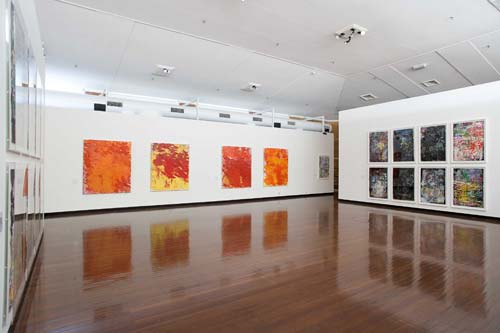
Aida Tomescu, Paintings and Drawings, Installation view, The Drill Hall Gallery, ANU, Canberra, 2009. Photo: Stuart Hay, ANU Photography.
Drill Hall Gallery, Australian National University, Canberra
1 October–8 November 2009
by Dr JANET McKENZIE
Aida Tomescu: Paintings and Drawings is showing at the Drill Hall Gallery, in Canberra where her exhibition is in keeping with the high standard of exhibitions there. Born in Romania, Tomescu graduated from the institute of Fine Arts, Bucharest. She moved to Australia in 1980 aged just 23, where she studied further at the City Art Institute in Sydney. Her successful exhibiting career, since then has been punctuated by key prizes: the Sulman Prize, (1996), the Wynne Prize (2001), and the Dobell Prize for Drawing (2003). Tomescu recalls that the art scene in Bucharest was closed in at the time, waiting for something from the wider world to impact upon it. Sydney by contrast, was liberating:
The distance and isolation are crucial for my work. From feeling closed in, I stepped outside. Even though I need to travel in Europe, gaining strength and clarity from revisiting works I love, I wouldn’t want to paint there. I need the space. I don’t think I could have done this work living anywhere else.2
Aida Tomescu: Paintings and Drawings, comprises 65 works completed since 1993; the exhibition is accompanied by a typically good, Drill Hall Gallery catalogue with an excellent essay by Deborah Hart, Senior Curator, Australian Painting and Sculpture post-1920, at the National Gallery of Australia, based on interviews with the artist. Tomescu’s art stands out in a vibrant visual culture in Australia, operating on numerous levels of association, at different paces. It is at once impassioned and poetic, brooding and vibrant, internally consistent and in possession of elegance and grace.
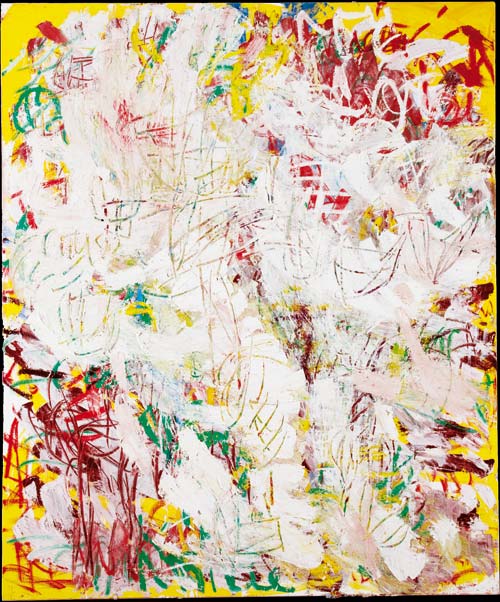
Aida Tomescu. Ash, 2009. Oil, pastel and oil pigment on linen, 184 x 154 cm. Copyright © Aida Tomescu. Photo: Jenni Carter.
Drawing is integral to Tomescu’s art practice. It is an unpredictable, and often delayed process where a work begins with a “sum of approximations” and gradually assumes a precise form. Her powerful abstract works often take months to complete, but the issues of figuration and abstraction is irrelevant to her; “There is no great figurative work that doesn’t work on an abstract level, the logic in it is indestructible. The works I love, the works that can keep me spellbound for hours exist outside of time. I need to see them because of the life in them, not the art in them”.3
Tomescu cites Giotto, Bellini and Titian as artists whose work she needs, for their great strength and clarity. Art as a commodity is anathema; art and the making of it are the essential stuff of life. “You come into the studio every day to find something that’s outside of yourself, that’s better than yourself. Something that travels the distance from whoever you are to that thing that eventually becomes the work. A painting or drawing can be measured by the distance an image can travel away from figuration, away from abstraction, (and away from the artist) in order to become itself – in order to become life”.4
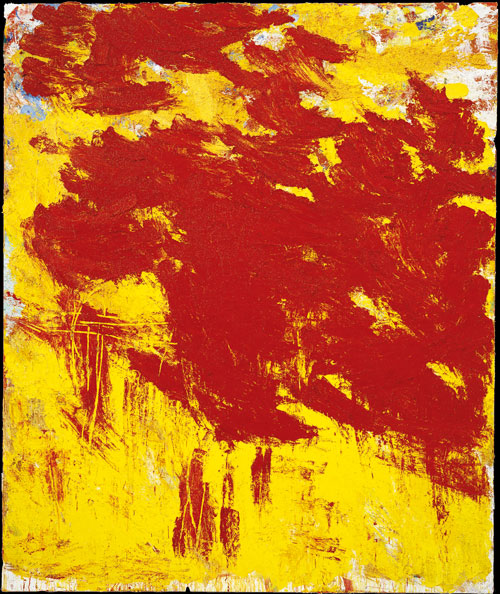
Aida Tomescu. Thor, 2007. Oil on canvas, 184 x 154 cm. Copyright © Aida Tomescu. Photo: Jenni Carter.
At the Institute of Fine Arts, Bucharest, Tomescu received a rigorous academic training beginning with years of drawing from plaster casts. Pencil then charcoal and experimentation with different materials followed. Far from finding the rigour stultifying, Tomescu enjoyed her course of instruction, where the same subject was drawn repeatedly, designed to enable students to identify subtle shifts and different ways of looking. “Most of all, it gave me the discipline of daily work, which I’ve never lost – the joy of staying with the work every day without necessarily expecting results”.5
After 2 years one of my greatest pleasures was to set myself up with the cast in front of me. You could fill them with joy once you began to get involved with what the work was trying to express… Perhaps what my training gave me were the seeds of understanding to slow down with an image. It was about allowing the image to work on you, finding answers from the act of looking repeatedly. It sowed the idea of questioning on canvas.6
Drawing has remained an essential part of Tomescu’s art practice. Drawings for her are journeys in themselves. There is extreme force and intensity in her works, and yet in spite of the high energy of her drawings there is also great subtlety. Tomescu sees in drawing a space where mood, movement and vibration form a particular experience.7
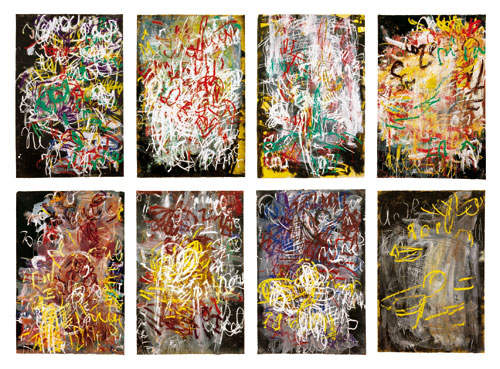
Aida Tomescu. All works are ink, pastel and oil pigment on Velin Arches, 120 x 80 cm. Top row, from left to right:
Fons I 2009; Fons 2009; Fons II 2009; Fons III 2009. Bottom row, from left to right: Sodium IV 2009; Sodium 2009; Sodium II 2009; Cyr 2009. Copyright © Aida Tomescu. Photo: Jenni Carter.
Drawing is also, “a form of questioning on paper. I think the trouble sometimes is that we expect a work to explain too much… if anything you want it to be alive, to stay open until it reaches a point where nothing feels arbitrary anymore”.8
Soon after her arrival in Sydney Aida Tomescu visited Gallery A, and was struck by the courage and energy in the works she saw there. She recalls the necessity of stepping back from her own working processes; and chose collage to free up her methods.
Changing material helped. Tearing the paper and not worrying about the edges. I began ripping bits of paper and also stapling unstretched canvas onto the wall. I was able to allow the edges of the canvas to participate in the making of the image without closing it in. I began re-working old paintings. It was a way of breaking out of being captive of previous habits.9
Tomescu’s collage works came to the attention of John Loane, master printer and founding director of the Victorian Print Workshop. At his suggestion Tomescu began to work in printmaking. Deborah Hart suggests, “Among the important aspects of printmaking to her artistic development as a whole, was the idea of working successively from one plate to the next – of working in series. For her the experience of printmaking was about working in an open-ended way, being alert to the myriad possibilities that present themselves”.10 Perhaps her recent work can be traced back to the seminal influence of printmaking.
In the Phosphor series of 2005, for example, the images are drawn with layers of white pastel on black etching proofs. The method started pragmatically, when she was working with master printer John Loane in 1986, as a means of maintaining a train of thought through the printmaking process. Now she uses unique state etching proofs to act as a ground, bringing to mind the Renaissance tradition where a ground was laid down before chalk or silverpoint drawings were made. The surface quality of the drawings is a rich black, in contrast to her chosen media such as white pastel and in more recent times a flurry of coloured pastels and oil stick. These works seem to share a certain poetic sensibility and playfulness with the work of Cy Twombly, yet her interests are diverse – from the Scrovegni Chapel in Padua, or Titian’s Pieta in Venice, the work of Malevich, to the poems of Paul Celan, or the novels of Thomas Bernhard. “It felt like quite a test to produce something that I am not always aware of seeing, but that I can sense. What I want to see is a unified presence in the work. I like to keep the tension of something that is full, that is on the threshold”.11
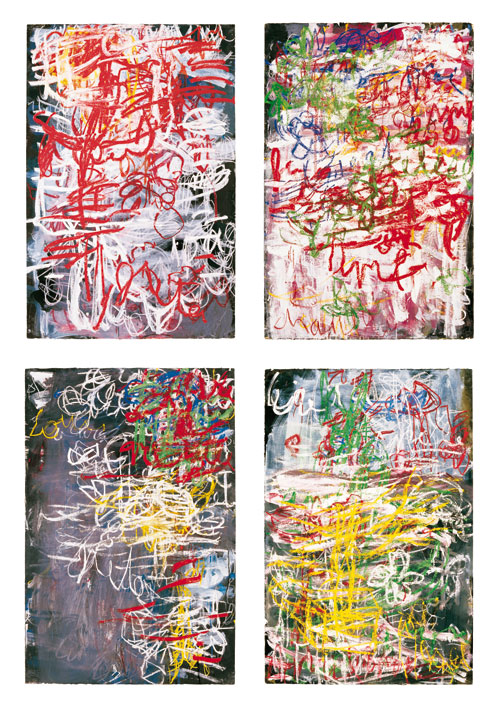
Aida Tomescu. All works are mixed media on paper, 120 x 80 cm. Top left: Louisiane, 2008. Top right: Neon, 2008. Bottom left: Ravel I, 2008. Bottom right: Poisson d’or, 2008. Copyright © Aida Tomescu. Photo: Jenni Carter.
Drawings done in the late nineties, for example the diptych, Negru III (2002) and Negru IV (2002), which was awarded the Dobell Prize for Drawing in 2003, were triggered by a small painting by New Zealand artist, Colin McCahon, A Candle in a Dark Room (1947) which itself was inspired by a poem. As McCahon had done before her, Tomescu explored light and dark – crisp, determined lines over a velvety black background. The drama possesses a majesty and grace, which resonates with “the subtle nuances of experience – of being and becoming”.12
Tomescu views painting as a form of “accumulation of experiences in the making of the work”. The materials themselves are used for their associative meaning, allowing “connections to be made more readily”.13 The creation of her works on paper and large canvasses both possess a tremendous sense of physical involvement. Hers is a deeply intuitive working process, “It is not about making a work of art as such but rather about discovering possibilities that take on a life of their own, becoming honed to the precision of a unified whole that feels inevitable”.14 As Tomescu explains:
Even though you have a glimpse of what the work might become, it needs to travel the distance towards its own reality. In the end it feels quite precise even if you have been through dark alleys and into no-man’s land… Matisse gave such a truthful definition of painting when he said that it was a means by which he practiced his intuition; intuition not taken for granted, not assumed in advance… The more you tap it, the deeper the layers that emerge.15
Tomescu captures a rare point where a unified, coherent presence emerges in the work.
In spite of the openness of the drawings they are intensively worked, wiped off repeatedly and re-configured looking for something that is unified full and ordered. I tend to begin a new working cycle almost always with paper. They often develop into series. Working on a sequence of drawings allows for fluidity, sets conditions for rapid changes, which suit my work. One thing changes, passes onto another, each drawing becoming both a work in itself, but also a step towards another, imminently productive of something else. All drawings are in the condition of open possibility, each drawing acting as a promise for future work.16
Aida Tomescu’s paintings and drawings are immediately recognisable – powerful and layered with a sensual energetic use of materials that look as if they inhabit the eye of the storm, or the aftermath of a physical upheaval, a lava like mass which heaves like the sea. Natural elements seem to dominate the surface of the paintings; in the drawings the mass is stripped back, yet the bones remain, the intensity that provides the underlying structure in her work, in all materials.
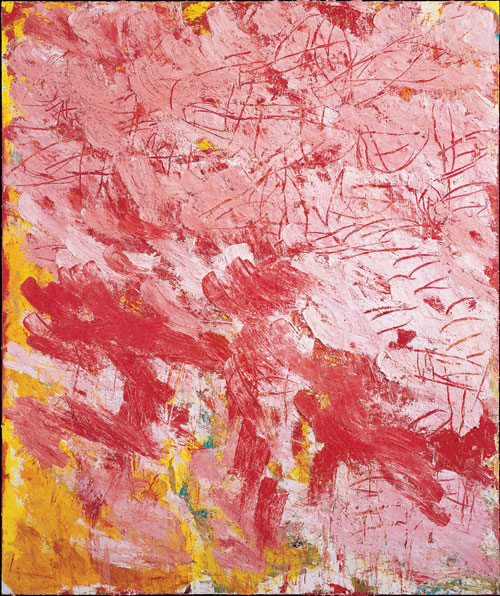
Aida Tomescu. Spora, 2008. Oil on canvas, 184 x 154 cm. Copyright © Aida Tomescu. Photo: Jenni Carter.
A friend of the artist suggested Windhover as a title for a painting by Tomescu, where layers of cobalt blue echo the sounds and movements of nature. Windhover was the title of Gerard Manley Hopkins’ poem of 1877. The windhover is a kestrel, a bird that can hover in the air, suddenly swooping downwards to avoid strong wind. The movement in Tomescu’s paintings and drawings capture something of the freedom and beauty of a bird in flight. Where Hopkins’ poetry was overtly religious, he was a Jesuit priest, the spirituality in Tomescu’s work is never overtly stated but always implied. One can feel exalted in the presence of her work, just as one is moved by Hopkins’ poetry or by the mysterious spaces in Titian’s Pieta. Tomescu’s drawings have an immediacy, a sense of urgency:
There is a moment when the surface I’ve been working with becomes very responsive – opening up intriguing possibilities; I am no longer working with a passive surface. With drawing the rhythm builds up in speed. I slowly reach a faster, more involved way of working. Time changes as the rhythm intensifies. You compress reality, you compress imagery, you can’t afford dead space in a work. But paradoxically there is also a slowness to the image, a delay. I am aware that I am doing contradictory things all the time, like trying to control the image, yet at the same time needing to unfix it, to have it breathe; being aware of the mark I am making that very moment as well as overseeing the whole image at once.17
The Drill Hall exhibition reveals the artist’s evocative use of colour, from volcanic reds, burnt oranges and yellows in works such as Lavinia (2007) and Parme (2007) to the cool, blues of Windhover (2005). She describes her organic, layering work methods:
I travel through their stages and eventually they form their own colour. I think they are very much about found colour. All the previous layers participate in forming that particular blue or yellow. As I scrape back into the work, the previous layers also participate in the making of that colour.18
Tomescu relies on travel to keep herself connected to her favourite works and to her European roots. One of the paintings she keeps returning to is Titian’s altarpiece, The Assumption of the Virgin (1518), in Santa Maria Gloriosa dei Frari in Venice. Perhaps we can locate paintings like Lavinia, keeping in mind Tomescu’s love and deep interest in Titian. The playful application of marks and smudges recalls Cy Twombly; in Lavinia a decidedly female quality persists, the name being that of Titian’s daughter, the flowing lines of paint perhaps referring to Lavinia’s long red hair.
I like titles that stay open, following the same trajectory as the works; titles that tune into the general character of the image but remain elusive. Sometimes they come from different language systems and have double meanings. The title for the recent series of drawings came from a Latin word fons which means fountain, as it felt like an overflowing of imagery that I was dealing with.19
Drawings and paintings in Aida Tomescu’s oeuvre play with and against each other. In recent years the character of her paintings grew to acquire something of the freshness, attack and open forms of her drawings. The result in all of her work is an organic whole. Tomescu enjoys defining her art so as to share the great adventure she experiences, day by day.
References
1. Aida Tomescu, quoted by John McDonald, “Undeniable Presence,” Australian Art Collector, Sydney, 2006.
2. AT quoted by Deborah Hart, Aida Tomescu: Paintings and Drawings, Drill Hall Gallery, Australian National University, Canberra, 2009, p.11.
3. AT quoted by McDonald, op.cit., p.107.
4. Ibid, p.107.
5. AT quoted by Laura Pia, “Infinitely Subtle Threads”, LOOK Magazine, AGNSW, Sydney, March 2009.
6. AT quoted by Hart, op.cit., p.10.
7. Aida Tomescu, “Statement On Drawing”, for Janet McKenzie March 2009.
8. AT quoted by Laura Pia, op.cit., p.22.
9. AT quoted by Hart, op.cit., p.11.
10. Ibid, p.11.
11. “On Drawing”, op.cit.
12. Hart, op.cit., p.11.
13. AT, ibid, p.13.
14. Ibid, p.15.
15. AT, ibid, p.15.
16. “On Drawing”, op.cit.
17 Ibid.
18. AT quoted by Hart, op.cit., p.18.
19. Ibid, p.18.